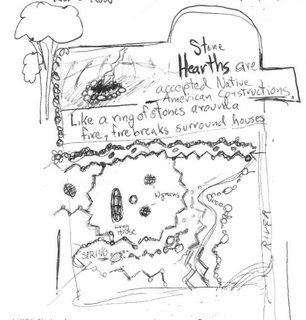
A feature that helps define a Late Archaic site is the use of a hearth, again illustrated by Wilbur:

Edward J. Platt, writing about Archaic Period Indians in “Reconstructing Prehistoric American Indian Cultures on Western Long Island, New York,” mentions hearths:
“That they were successful hunters can be attested to by the points being located in association with a large hearth roasting pit of concentrated fire shattered rocks. The hearth is half circled, on the west side (against winter winds?) with a group of large standing-on-end glacial cobblestones. They are directly associated with a large flat top glacial bolder measuring some 90cm.(35 inches) in diameter (see photograph in Revised Introduction). Did it serve as a food processing or Stone Age table? In-depth studies of the entire contents of the feature (excluding the glacial bolder) have been removed for scientific laboratory analysis and subsequent report...”
From: http://www.hoflink.com/~bayside/nyia/archaic.html
Tara Prindle has a very nice website called NativeTech on which you can find directions to recreate a wigwam:
http://www.nativetech.org/wigwam/construction.html
She says, “You should have a central hearth (about three feet across, or a foot and a half in diameter), which heated the wigwam in cold weather, and was used for cooking in rainy weather. Dish out the hearth to a depth of about 6 inches in the center, creating a basin. Line the hearth with small cobbles or clay, put stones around the hearth to help contain the fire.”
This is her drawing:

Containing a fire inside a wigwam is a good idea. I imagine the people who did so were the people who survived the longest.
So there is some accepted and documented Native American Stonework.
Exploring the stone rows around “The Fresh Water Fishing Place” I read about in an old history, I thought they might point out the site of “The Wigwams,” said to be there in the years around 1700.
I looked at a topographic map and found a likely spot, a large flat level area near the river. I followed remnants of a zigzag stone row to this spot and shortly after wrote some hearth thoughts down.
And I drew this picture:

You can see a hearth inside a wigwam in my drawing and below it a "bird's eye view" of what I think are wigwam sites and some stone rows that I hope convey the idea that, much like a hearth inside a wigwam, a zigzag stonework firebreak around the wigwams (and the Sachem's "Big Wigwam") would prevent a spread of fire. Other areas could be selectively burned (or not).
And I'll stop here for now, promising that this will be continued...
No comments:
Post a Comment